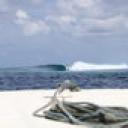Why does The Mid get a kick on the incoming tide?


Personally, I think the "lulls in swell right at the top of the tide" is probably just a coincidence. I've heard this theory mentioned from time to time at many locations around the country but I really can't think of a plausible reason for it.
Essentially, the outgoing tide shifts a large volume of water out of the Gulfs, which impedes incoming swell energy. The incoming tide - which offers far less resistance to the incoming swell energy - allows the swell to reach its full size potential. Craig Brokensha's done a stack of work in this field though (for his Honours) and can offer some great insight as to the gulf's tidal patterns.
Of much more interest to me is the relationship between swell periods and surf size on the Mid Coast. We're all familiar with the general rule of thumb that larger swell periods amplify wave heights significantly at exposed surf spots, compared to smaller swell periods.
However, I've noticed that the Mid Coast often falls short of expectations during large swell period events (ie 18-20 seconds), and that lower swell period events (ie 10-11 seconds) can sometimes perform better than expected.
The reasoning behind this is that large swell periods penetrate much deeper into the ocean than small swell periods, so by the time they've passed through Investigator Strait, the swell energy has already interacted with the ocean floor (ie near the continental shelf), and therefore suffers much greater frictional effects (ie size loss).
However, lower swell periods are more likely to pass straight through Investigator Strait without feeling the ocean floor at all - ie retaining more of their energy until they near the coast (therefore, being a little bigger at the beach than what would normally be expected).
Tie this in with the topic heading (surf size related to tidal phases) and it shows just how difficult the Mid Coast can be to forecast for.
This whole idea is much more complex and there's a myriad of other parameters that need to be explored in more detail, but the basic hypothesis is reasonably sound. I'll hopefully get around to doing some proper research on it (and a bunch of other topics!) in the future.


any truth that over the last 35yrs the entrance to the gulf has shallowed and silted up somewhat...2mts shallower than the 1970s ? reducing the swell size and knocking some grunt out of the waves [grunt was there ever any on the mid] interesting to cross check some shipping charts from then till now re the depths ?


Two metres wouldn't make much difference Victor.
I've spoken to plenty of people across a wide range of ages - surfers in their 60's, 50's, 40's and 30's - all of whom reckon that the surf on the Mid was better 'back in the day'.
I reckon it's selective memory :).


I agree with you Ben on swell size being bigger 'back in the day' - it's always bigger in hindsight.
I've heard from some older crew that the banks at Moana were a lot better 'back in the day' due to the amount of sea grass that was around then compared to now. Now you're lucky to see any at all. Guess this is possible?


Everyone says the mid was better back in the old days,I dont agree, heres my theory.Surfing was fairly new back then and everything looked bigger and better through our naive eyes in the 70s.The days we now call 2ft were 4ft.back then and the rare 4ft swells were 6ft.To a novice paddling out at 3 poles a 2ft clean up set can look like impending doom.Plus as TB said you only remember the exceptional days (which would probably look pretty lame if you saw footage now.)The only thing thats ever been consistent about the Mid is its inconsistency.However Seaford was probably hollower before the stormwater killed the reef. The Mid gets hundreds of 1ft. days per year and tidal assistance boosts it to a rideable 18inches.


Well said old-dog you summed it up beautifully.
Love the quote 'The only thing thats ever been consistent about the Mid is its inconsistency'....


I do think that, for what is essentially a reef break Gulls can change quite a bit. It seems to depend a lot on the volume of sand moving up and down the PW area between Snapper Point and Maslins.

Question for Ben... As you would know its part of SA folklore that when there is swell at the Mid - hang out for the incoming tide as the swell will invariably kick.
Having surfed the Mid for close on 30 years I would agree the empirical evidence seems to weigh slightly in favor of this assertion. However, having dabbled a little in Oceanographiy (I did Earth Science at Flinders too) I cant see why a very loooong period tidal wave could actually impact on a groundswell where the bathymetry is sufficiently deep for the waves not to 'feel the botton' and lose energy across Investogator Strait regardless of tide. I have also experienced (again emprical and possibly imaginary) regular lulls in swell right at the top of the tide as if it had completely died in the ass so the bathymetry argument loses weight.
Curious as to your thoughts and whether this can be modelled mathemtically.
(in any case these days being a contraian I prefer to sneak down on the outgoing tide and have had tremendous uncrowded sessions - going in to watch the hoards arrive in expecation of the incoming tide)